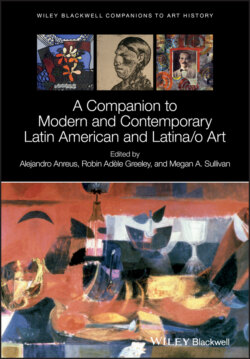Читать книгу A Companion to Modern and Contemporary Latin American and Latina/o Art - Группа авторов - Страница 58
Notes
Оглавление1 1 This discussion draws on material previously published in Sims L.S. (2002). Wifredo Lam and the International Avant‐Garde, 1923–1982. Austin: University of Texas Press, and my essay “Surrealism in the Caribbean: The Art and Politics of Liberation at the Crossroads of the World,” published in Caribbean: Art at the Crossroads of the World, exh. cat. (New York: El Museo del Barrio, in association with Yale University Press, 2012), 223–239.
2 2 See “Chronology,” in Balderrama, M. (ed.) (1992) Wifredo Lam and His Contemporaries (exh. cat.), 94. New York: The Studio Museum in Harlem.
3 3 See René Crevel, “Colonies,” Le surréalisme au service de la révolution 1 (July 1930): 9–12; “Bobards and fariboles,” also by Crevel, in number 2 (October 1930): 78 of the same periodical, and in number 5 (May 1933) an article by the Martiniquan writer Jules M. Monnerot, “A partir de quelques traits particuliers à la mentalité civilisée,” 35–37.
4 4 It should be noted, though, that Lam himself encouraged a less literal comprehension of his work. He pointed out that the title of The Jungle “has nothing to do with the real countryside of Cuba, where there is no jungle but woods, hills and open country, and the background of the picture is a sugar cane plantation.” For him this painting “was intended to communicate a psychic state” rather than a geographical phenomenon.
5 5 Carpentier quoted in Herzberg, “Wifredo Lam,” p. 68 in Balderamma (1992).
6 6 Interview with Bélance, R. (1978). In: André Breton: What is Surrealism? Selected Writings. (ed. F. Rosemont), 255. New York: Monad Press for the Anchor Foundation, Inc..
7 7 Ibid., 256.
8 8 See Rosemont (1978), pp. 258–260; and André Breton: La beauté convulsive (1991), pp. 365 and 394.
9 9 See Rosemont (1978), pp. 258–260; André Breton: La beauté convulsive (1991), pp. 365 and 394; and Kelley (2009), p. 67.
10 10 Rosemont (1978), pp. 258–260 and Kelley (2009), p. 67.
11 11 Mark Rothko quoted in Sandler (1970), p. 67.
12 12 Rosemont (1978), pp. 258–260 and Kelley (2009), p. 67.
13 13 Ibid.
14 14 Monosiet, P. (1978). A chronology of Haitian Art. In: Haitian Art (exh. cat., ed. U. Stebich), 12. New York: The Brooklyn Museum in association with Harry N. Abrams, Inc., Publishers.
15 15 Ibid., pp. 7 and 11.
16 16 Ibid., p. 7.
17 17 Ibid., p. 12.
18 18 Ibid., p. 48.
19 19 Sims, L.S., (1992). Rethinking the destiny of line in painting: The later work of Wifredo Lam. In: Wifredo Lam: A Retrospective of Works on Paper (exh. cat., ed. C. Merewether), 48. New York: Americas Society.
20 20 Lam quoted in Vicenti (1972).
